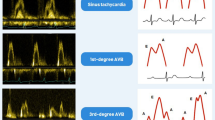Abstract
Symptoms arising from cardiac arrhythmias are often transient. Consequently, defining the responsible rhythm disturbance remains a challenge. However, absent a confident diagnosis of the arrhythmic basis for the symptoms, it is not possible to develop an effective treatment strategy. The implantable loop recorder (ILR) has become a valuable element in the evaluation of patients with suspected intermittent arrhythmia related symptoms. In this regard, clinical studies have not only demonstrated its superior effectiveness compared to other monitoring modalities, but even suggest that it may be cost-effective for the ILR to be used at an earlier stage of the evaluation strategy.
Similar content being viewed by others
References
Brignole M, Alboni P, Benditt D, et al. Guidelines on management (diagnosis and treatment) of syncope. Eur Heart J 2001;22:1256–1306.
Krahn AD, Klein GJ, Norris C, et al. The etiology of syncope in patients with negative tilt table and electrophysiologic testing. Circulation 1995;92:1819–1824.
Krahn A, Klein GJ, Yee R, Norris C. Final results from a pilot study with an implantable loop recorder to determine the etiology of syncope in patients with negative noninvasive and invasive testing. Am J Cardiol 1998;82:117–119.
Krahn AD, Klein GJ, Yee R, Takle-Newhouse T, Norris C. Use of an extended monitoring strategy in patients with problematic syncope. Reveal Investigators. Circulation 1999;26:99:406–410.
Seidl K, Rameken M, Breuning S, et al. Diagnostic assessment of recurrent unexplained syncope with a new subcutaneously implantable loop recorder. Europace 2000;2:256–262.
Krahn A, Klein GJ, Yee R, Skanes AC. Randomized assessment of syncope trial. Conventional diagnostic testing versus a prolonged monitoring strategy. Circulation 2001;104:46–51.
Fujimura O, Yee R, Klein G, Sharma A, Boahene A. The diagnostic sensitivity of electrophysiologic testing in patients with syncope caused by transient bradycardia. N Engl J Med 1989;321:1703–1707.
Brignole M, Menozzi C, Bottoni N, et al. Mechanisms of syncope caused by transient bradycardia and the diagnostic value of electrophysiologic testing and cardiovascular reflexivity maneuvers. Am J Cardiol 1995;76:273–278.
Lacroix D, Dubuc M, Kus T, Savard P, Shenasa M, Nadeau R. Evaluation of arrhythmic causes of syncope: Correlation between Holter monitoring, electrophysiologic testing, and body surface potential mapping. Am Heart J 1991;122:1346–1354.
Moazez F, Peter T, Simonson J, Mandel W, Vaughn C, Gang E. Syncope of unknown origin: Clinical, noninvasive, and electrophysiologic determinants of arrhythmia induction and symptom recurrence during long-term follow-up. Am Heart J 1991;121:81–88.
Moya A, Brignole M, Menozzi C, Garcia-Civera R, Tognarini S, Mont L, Botto G, Giada F, Cornacchia D and ISSUE Investigators. Mechanism of syncope in patients with isolated syncope and in patients with tilt-positive syncope. Circulation 2001;104:1261–1267.
Menozzi C, Brignole M, Garcia-Civera R, et al. Mechanism of syncope in patients with heart disease and negative electrophysiologic test. Circulation 2002;105:2741–2745.
Brignole M, Menozzi C, Moya A, et al. Mechanism of syncope in patients with bundle branch block and negative electrophysiologic test. Circulation 2001;104:2045–2050.
Crawford MH, Bernstein SJ, Deedwania PC, et al. ACC/AHA Guidelines for Ambulatory Electrocardiography. J Am Coll Cardiol 1999;34:912–948 (Executive summary and recommendations. Circulation 1999;100:886–893).
Benditt DG, Chen M-Y, Hansen R, Buetikofer J, Lurie KG. Characterization of subcutaneous microvascular blood flow during tilt-table-induced neurally-mediated syncope. J Am Coll Cardiol 1995;25:70–75.
Brignole M, Menozzi C, Corbucci G, Garberoglio B, Plicchi G. Detecting incipient vasovagal syncope: Intraventricular acceleration. PACE 1997;20(Supp II):801–805.
Occhetta E, Bortnik M, Pedrigi C, Paffoni P, Signorotti F, Maffe S, Vassanelli C. Pacing rate automatic reaction to neuromediated hemodynamic changes. In: Santini M, ed. Progress in Clinical Pacing Rome: CEPI Srl, 2000:542–547.
Plicchi G, Marcelli M, Parlapiano M, Bombardini T. PEA I and PEA II based implantable haemodynamic monitor: Pre clinical studies in sheep. Europace 2002;4:49–54.
Grubb BP, Wolfe DA, Samoil D, Hahn H, Elliott L. Adaptive rate pacing controlled by right ventricular pre-ejection interval for severe refractory orthostatic hypotension. PACE 1993;16:801–805.
Petersen MEV, Williams TR, Erickson M, Sutton R. Right ventricular pressure, dP/dt and PEI, during tilt-induced vasovagal syncope. PACE 1997;20(Supp II):806–809.
Osswald E. Correlation of intracardiac impedance and right ventricular contractility during dobutamine stress test. In: Raviele A, ed. Cardiac Arrhythmias, Venice: Centro Scientifico Editore. 1997:89.
Author information
Authors and Affiliations
Corresponding author
Rights and permissions
About this article
Cite this article
Benditt, D.G., Ermis, C., Pham, S. et al. Implantable Diagnostic Monitoring Devices for Evaluation of Syncope, and Tachy- and Brady-Arrhythmias. J Interv Card Electrophysiol 9, 137–144 (2003). https://doi.org/10.1023/A:1026220020639
Issue Date:
DOI: https://doi.org/10.1023/A:1026220020639




